文化意象的英汉翻译_朱元
- 格式:pdf
- 大小:126.59 KB
- 文档页数:2
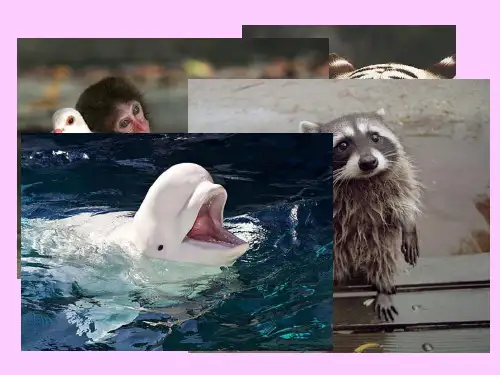
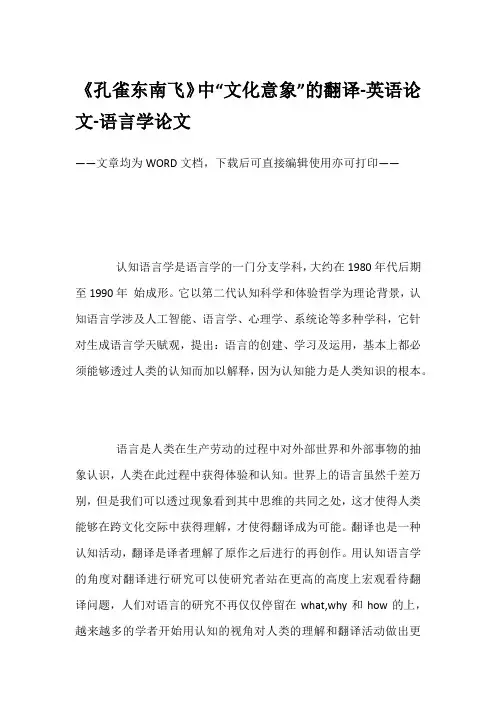
《孔雀东南飞》中“文化意象”的翻译-英语论文-语言学论文——文章均为WORD文档,下载后可直接编辑使用亦可打印——认知语言学是语言学的一门分支学科,大约在1980年代后期至1990年始成形。
它以第二代认知科学和体验哲学为理论背景,认知语言学涉及人工智能、语言学、心理学、系统论等多种学科,它针对生成语言学天赋观,提出:语言的创建、学习及运用,基本上都必须能够透过人类的认知而加以解释,因为认知能力是人类知识的根本。
语言是人类在生产劳动的过程中对外部世界和外部事物的抽象认识,人类在此过程中获得体验和认知。
世界上的语言虽然千差万别,但是我们可以透过现象看到其中思维的共同之处,这才使得人类能够在跨文化交际中获得理解,才使得翻译成为可能。
翻译也是一种认知活动,翻译是译者理解了原作之后进行的再创作。
用认知语言学的角度对翻译进行研究可以使研究者站在更高的高度上宏观看待翻译问题,人们对语言的研究不再仅仅停留在what,why和how的上,越来越多的学者开始用认知的视角对人类的理解和翻译活动做出更加本质和始源性的解释。
本文从认知语言学对语言共性的解释角度,结合《孔雀东南飞》的两个英译本,对典籍中的文化负载词是的可译性问题进行求证,以及如何操作的问题给出肯定的回答及解决办法。
1 可译性(translatability)可译性(translatability)一直是翻译界争论的话题。
许多西方翻译理论都各给出了回答。
奈达(Eugene Nida)在论文《翻译:可能与不可能(Translation:possible and Impossible)》(1991)中提出的最切近的自然对等物(closest natural equiva-lents);以及卡特福德(J. C. Catford)在《翻译的语言学理论(ALinguistic Theory of Translation)》中提出的可译限度(limitsof translatability)都对可译性(translatability)进行了深入系统的探讨。
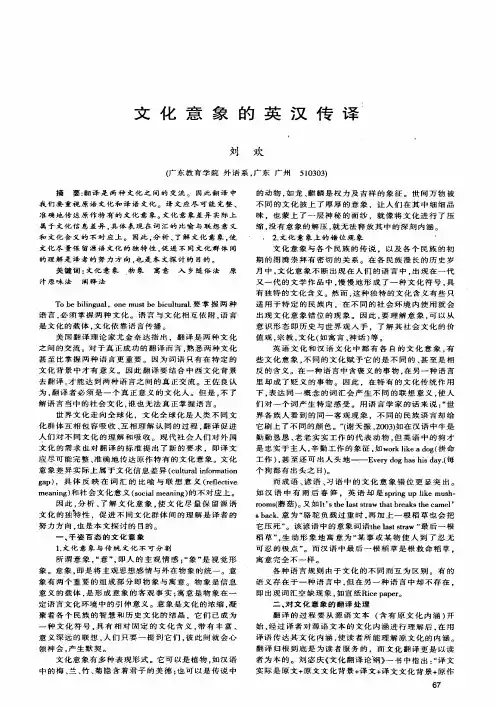

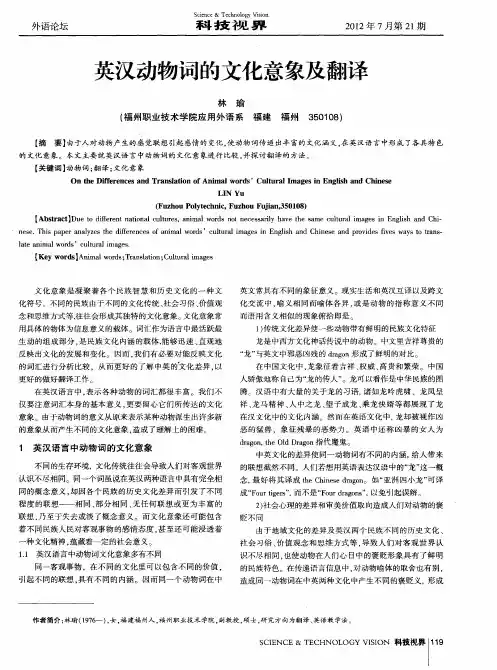
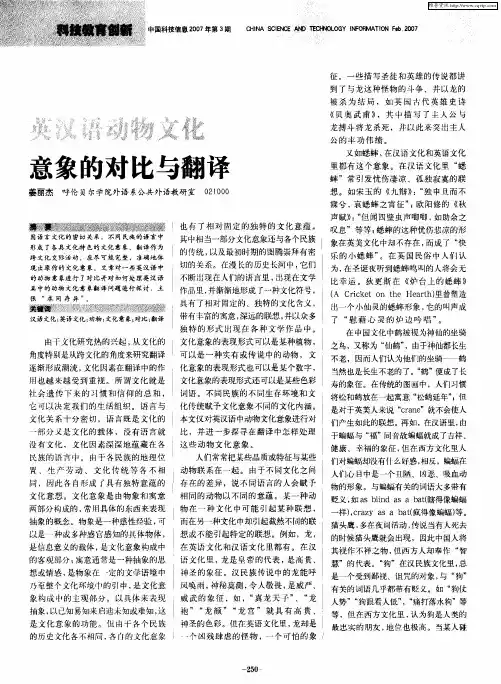
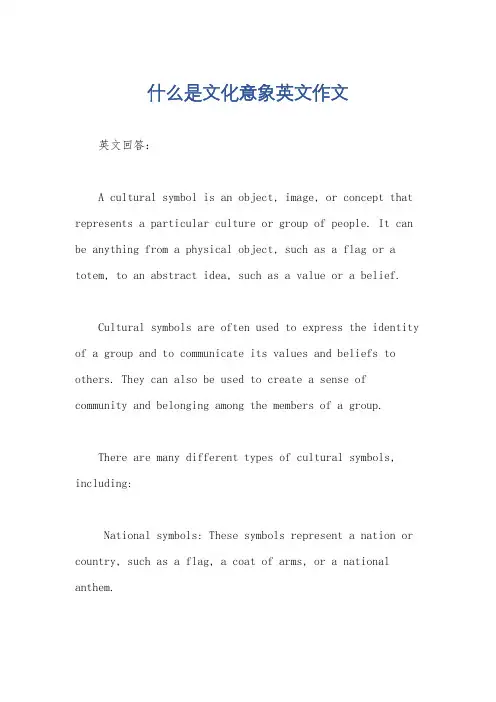
什么是文化意象英文作文英文回答:A cultural symbol is an object, image, or concept that represents a particular culture or group of people. It can be anything from a physical object, such as a flag or a totem, to an abstract idea, such as a value or a belief.Cultural symbols are often used to express the identity of a group and to communicate its values and beliefs to others. They can also be used to create a sense of community and belonging among the members of a group.There are many different types of cultural symbols, including:National symbols: These symbols represent a nation or country, such as a flag, a coat of arms, or a national anthem.Religious symbols: These symbols represent aparticular religion, such as a cross, a crescent moon, or a Star of David.Social symbols: These symbols represent a particular social group, such as a gang, a club, or a sports team.Cultural symbols: These symbols represent a particular culture, such as a totem, a mask, or a dance.Cultural symbols are often complex and can havemultiple meanings. They can be interpreted in differentways by different people, depending on their cultural background and experiences.中文回答:文化意象是指代表特定文化或人群的物件、图像或概念。
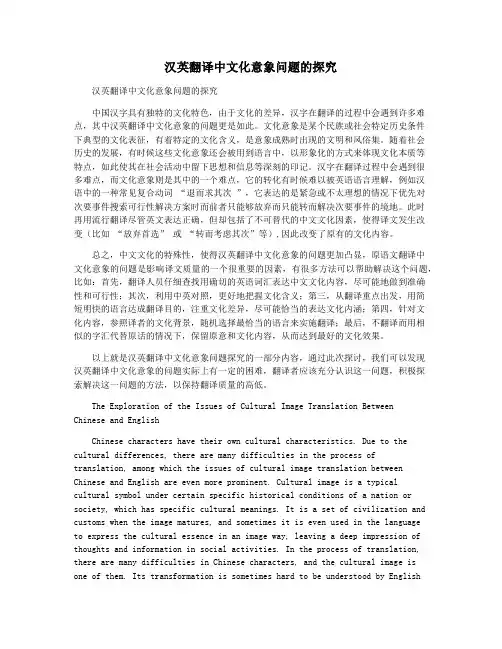
汉英翻译中文化意象问题的探究汉英翻译中文化意象问题的探究中国汉字具有独特的文化特色,由于文化的差异,汉字在翻译的过程中会遇到许多难点,其中汉英翻译中文化意象的问题更是如此。
文化意象是某个民族或社会特定历史条件下典型的文化表征,有着特定的文化含义,是意象成熟时出现的文明和风俗集。
随着社会历史的发展,有时候这些文化意象还会被用到语言中,以形象化的方式来体现文化本质等特点,如此使其在社会活动中留下思想和信息等深刻的印记。
汉字在翻译过程中会遇到很多难点,而文化意象则是其中的一个难点,它的转化有时候难以被英语语言理解,例如汉语中的一种常见复合动词“退而求其次”,它表达的是紧急或不太理想的情况下优先对次要事件搜索可行性解决方案时而前者只能够放弃而只能转而解决次要事件的境地。
此时再用流行翻译尽管英文表达正确,但却包括了不可替代的中文文化因素,使得译文发生改变(比如“放弃首选” 或“转而考虑其次”等),因此改变了原有的文化内容。
总之,中文文化的特殊性,使得汉英翻译中文化意象的问题更加凸显,原语文翻译中文化意象的问题是影响译文质量的一个很重要的因素,有很多方法可以帮助解决这个问题,比如:首先,翻译人员仔细查找用确切的英语词汇表达中文文化内容,尽可能地做到准确性和可行性;其次,利用中英对照,更好地把握文化含义;第三,从翻译重点出发,用简短明快的语言达成翻译目的,注重文化差异,尽可能恰当的表达文化内涵;第四,针对文化内容,参照译者的文化背景,随机选择最恰当的语言来实施翻译;最后,不翻译而用相似的字汇代替原话的情况下,保留原意和文化内容,从而达到最好的文化效果。
以上就是汉英翻译中文化意象问题探究的一部分内容,通过此次探讨,我们可以发现汉英翻译中文化意象的问题实际上有一定的困难,翻译者应该充分认识这一问题,积极探索解决这一问题的方法,以保持翻译质量的高低。
The Exploration of the Issues of Cultural Image Translation BetweenChinese and EnglishChinese characters have their own cultural characteristics. Due to the cultural differences, there are many difficulties in the process oftranslation, among which the issues of cultural image translation between Chinese and English are even more prominent. Cultural image is a typicalcultural symbol under certain specific historical conditions of a nation or society, which has specific cultural meanings. It is a set of civilization and customs when the image matures, and sometimes it is even used in the languageto express the cultural essence in an image way, leaving a deep impression of thoughts and information in social activities. In the process of translation, there are many difficulties in Chinese characters, and the cultural image is one of them. Its transformation is sometimes hard to be understood by Englishlanguage. For example, a common compound verb in Chinese, "退而求其次”, conveys the state that when confronted with urgent and less ideal situation, one prioritizes searching for feasible solutions for secondary events, while the former can only give up and focus on solving the secondary ones. At this time, if popular translation is used, although the English expression is correct, it includes irreplaceable Chinese cultural factors and thus the translation changes (for example, "Give up the first choice" or "Turn to consider the secondary ones” and so on), thus changing the original cultural content.Above is just a part of the exploration of the issues of cultural image translation between Chinese and English. Through this exploration, we can find that there are actually certain difficulties in the translation of cultural images between Chinese and English. The translator should fully understandthis problem and actively explore the methods to solve it in order to maintain the quality of the translation.。
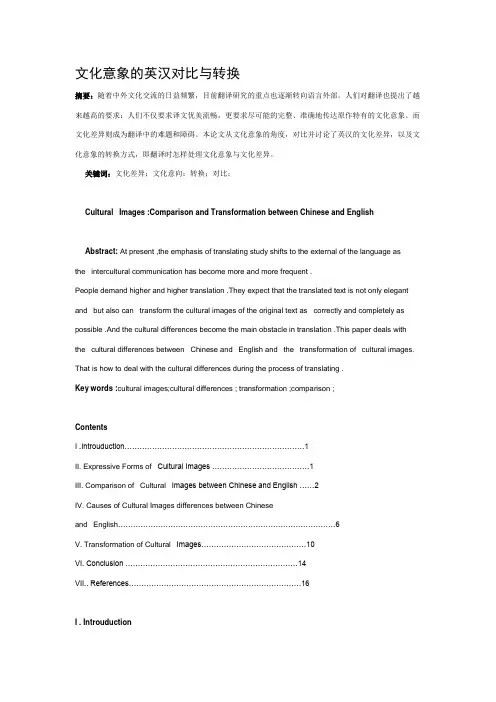
文化意象的英汉对比与转换摘要:随着中外文化交流的日益频繁,目前翻译研究的重点也逐渐转向语言外部。
人们对翻译也提出了越来越高的要求:人们不仅要求译文优美流畅,更要求尽可能的完整、准确地传达原作特有的文化意象。
而文化差异则成为翻译中的难题和障碍。
本论文从文化意象的角度,对比并讨论了英汉的文化差异,以及文化意象的转换方式,即翻译时怎样处理文化意象与文化差异。
关键词:文化差异;文化意向;转换;对比;Cultural Images :Comparison and Transformation between Chinese and EnglishAbstract: At present ,the emphasis of translating study shifts to the external of the language asthe intercultural communication has become more and more frequent .People demand higher and higher translation .They expect that the translated text is not only elegant and but also can transform the cultural images of the original text as correctly and completely as possible .And the cultural differences become the main obstacle in translation .This paper deals with the cultural differences between Chinese and English and the transformation of cultural images. That is how to deal with the cultural differences during the process of translating .Key words :cultural images;cultural differences ; transformation ;comparison ;ContentsI .Introuduction (1)II. Expressive Forms of Cultural Images (1)III. Comparison of Cultural Images between Chinese and English (2)IV. Causes of Cultural Images differences between Chineseand English (6)V. Transformation of Cultural Images (10)VI. Conclusion (14)VII.. References (16)I . IntrouductionGenerally speaking ,cultural images is the combination of peop le’s wisdom and historyculture .Among them most cultural images have close relations with a people’s legend and its original totems .During the long process of history development ,those legend and totems appeared constantly in language ,literary and artistic works .Years and years ,they developed into a kind of culturalsemiotics ,and have relatively fixed unique cultural meaning .Some have colorful and far-reaching association.In the same language community ,people can understand each other when they speakOf those images .but in different language communities ,people may not understand each other because different language communities may have different cultural images which have different associative meanings . Of course it is difficult for translators to translate the original text into the target language .When we transform the cultural images ,we should pay attention to the cultural differences between two languages .II. Expressive Forms of Cultural ImagesCultural images have many different kinds of expressive forms . It can be a kind of plant ,such aspine ,plum blossom,bamboo,orchid,chrysanthemum in Chinese ,and oak ,olive tree,whitebirch ,rose ,tulip in English .It can be an image of adjactive phrases,idioms ,proverbs and allusions,such as “蛇足”in “画蛇添足”,“诸葛亮”in “三个臭皮匠顶个诸葛亮”in Chinese , and “a fifth wheel ”in “to put a fifth wheel to the coach ”, “Rome ”in “All roads lead to Rome.”in English .It can also be a kind of animal ,such as“乌鸦”“喜鹊”“龙”in Chinese ,and “owl ” “lion”“bear” in English . It can be a number,such as“三”and “八”In Chinese , “seven” and“thirteen ” in English .In Chinese“三”not only means “three”, but “many”, e.g. “三思而后行” And “八”not only means “eight”, but “good luck and good fortune” because it is homophonic with“发”in Chinese .In English , “seven” has similar associative meaning with “三” in Chinese such as “at seven-league stride” .But in English “thirteen” implies unlucky meaning.III. Comparison of Cultural Images between Chinese and EnglishEast and west may have the same images ;but these images may have different associative meanings in English or Chinese .In this part , the paper deals with the cultural images from four aspects.1. Cultural images with same reference meanings, but with different associative meanings“dragon ”and “龙” refer to the same animal in legend. In Chinese “ ”has commendatory meaning. It is the representative of power, aristocrat and holy. “龙”in Chinese legend can control the forces of nature . It is mysterious and respectable. So it represents majesty and f orce in Chinese. And the phrases made by “ ” have caught the color of noble and holy. e.g. “真龙天子” “龙颜大怒” “龙的传人” “望子成龙”. But in English “dragon” is a fierce and cruel monster .It has derogative meaning. And it is a terrible symbol. So Chinese will be proud of being a descendant of dragon .But westerners will not feel any pride to be an offspring of dragon“Dog” and“狗”also refer to the same animal .In Chinese dog is a kind of derogative animal. It is always cursed and despised .Hence almost all phrases with“狗”have derogative meaning , e.g. “狗胆包天”“狗急跳墙”“狗眼看人低”“狗嘴里吐不出象牙” etc. But in western society, dog is a good friend of people, e.g. “You’re a lucky dog.” “I’m too old a dog to learn new tricks.” “Every dog has his day.” “Give a dog a bad name and hang him.” These sayings do not have any derogative meaning at all. People don’t feel shameful to compare himself to a dog.“Cricket” and “蟋蟀” refer to a small, brown, jumping insect which make a shrill noise by rubbing its front wings together. But English people regard cricket as a merry and hopeful image, such as “as merry as a cricket” in Shakespeare’s language.. But Chinese people regard cricket as a sad and cold image, such as “独申旦而不寐兮,哀蟋蟀之宵征。
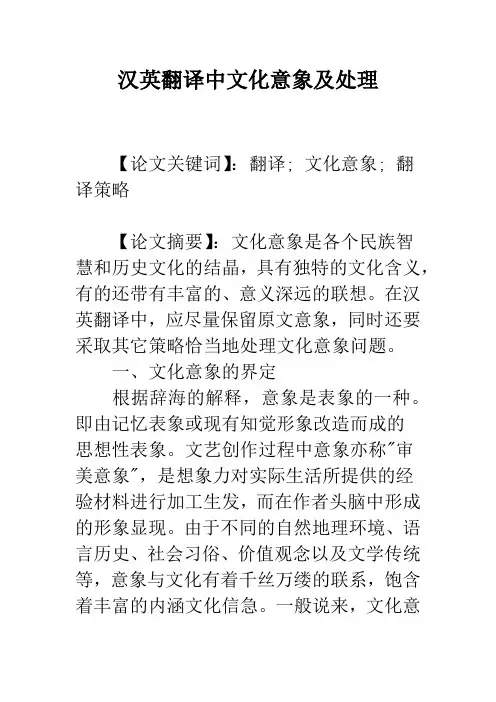
汉英翻译中文化意象及处理【论文关键词】:翻译; 文化意象; 翻译策略【论文摘要】:文化意象是各个民族智慧和历史文化的结晶,具有独特的文化含义,有的还带有丰富的、意义深远的联想。
在汉英翻译中,应尽量保留原文意象,同时还要采取其它策略恰当地处理文化意象问题。
一、文化意象的界定根据辞海的解释,意象是表象的一种。
即由记忆表象或现有知觉形象改造而成的思想性表象。
文艺创作过程中意象亦称"审美意象",是想象力对实际生活所提供的经验材料进行加工生发,而在作者头脑中形成的形象显现。
由于不同的自然地理环境、语言历史、社会习俗、价值观念以及文学传统等,意象与文化有着千丝万缕的联系,饱含着丰富的内涵文化信急。
一般说来,文化意象大多凝聚着各个民族的智慧和历史文化的结晶,其中相当一部分文化意象还与各个民族的传说以及各个民族初民时一期的图腾崇拜有着密切的关系。
在各个民族漫长的历史岁月里,它们不断出现在人们的语言里,出现在一代又一代的文艺作品里,它们慢慢形成为一种文化符号,具有了相对固定、独特的文化含义,有的还带有丰富的、意义深远的联想,人们只要一提到它们,彼此间就立刻心领神会,很容易达到思想的沟通。
文化意象蕴含的浓厚的文化色彩通常使得其在一定程度上具有语言不可译和文化不可译性。
前者是指目标语没有与原语文本相对应的语言形式,后者是指与原语相关的语境特征在译语文化中不存在。
尽管翻译时困难重重,人类是有共性的,语言也是有共性的,这就构成了语言可译性的基础;不同民族间的往来和文化的大融合则构成了文化可译性的基础。
总的来说,只要采取适当的方法策略,文化意象的可译性还是大于不可译性的。
二、汉英翻译中文化意象的处理翻译是信息的传输,文化意象翻译就是文化信息的传输。
传达文化意象,一是译者的职责,即译者不应满足于传达原文文化意象的一般意义,而应把尽最大可能传达原文的文化意象也视为自己的一种职责。
二是对读者的信任,即译者应该相信读者随着民族际文化交流的日益频繁,接触到的外来文化日益增多,已经有能力接受带有外来文化印记的各种文化意象。
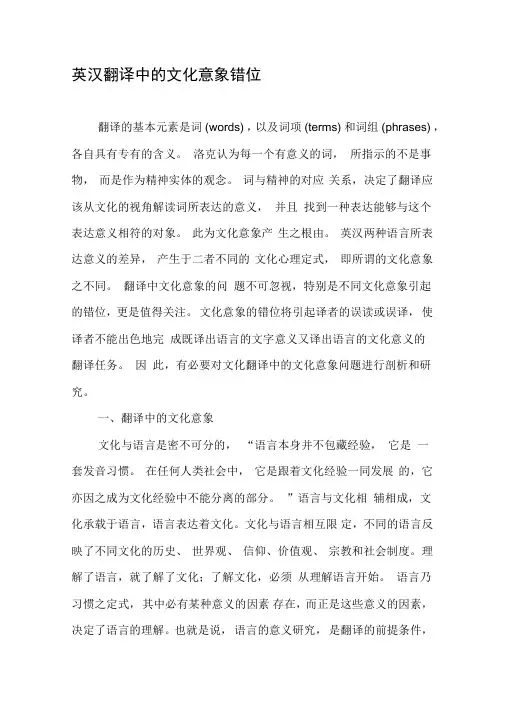
英汉翻译中的文化意象错位翻译的基本元素是词(words) ,以及词项(terms) 和词组(phrases) ,各自具有专有的含义。
洛克认为每一个有意义的词,所指示的不是事物,而是作为精神实体的观念。
词与精神的对应关系,决定了翻译应该从文化的视角解读词所表达的意义,并且找到一种表达能够与这个表达意义相符的对象。
此为文化意象产生之根由。
英汉两种语言所表达意义的差异,产生于二者不同的文化心理定式,即所谓的文化意象之不同。
翻译中文化意象的问题不可忽视,特别是不同文化意象引起的错位,更是值得关注。
文化意象的错位将引起译者的误读或误译,使译者不能出色地完成既译出语言的文字意义又译出语言的文化意义的翻译任务。
因此,有必要对文化翻译中的文化意象问题进行剖析和研究。
一、翻译中的文化意象文化与语言是密不可分的,“语言本身并不包藏经验,它是一套发音习惯。
在任何人类社会中,它是跟着文化经验一同发展的,它亦因之成为文化经验中不能分离的部分。
”语言与文化相辅相成,文化承载于语言,语言表达着文化。
文化与语言相互限定,不同的语言反映了不同文化的历史、世界观、信仰、价值观、宗教和社会制度。
理解了语言,就了解了文化;了解文化,必须从理解语言开始。
语言乃习惯之定式,其中必有某种意义的因素存在,而正是这些意义的因素,决定了语言的理解。
也就是说,语言的意义研究,是翻译的前提条件,不了解翻译语句所真实表达的意义,何谈翻译的语言信息交流?值得注意的是,译者在语言的翻译过程中,下意识地以本族语固有的意义,去删节、套用或篡改原语言所表达的意义,从而引起翻译的误译。
语言的定式决定于意义的表达,这种意义表达的成因相当复杂,而其中最具影响力的当属文化因素。
单纯地把对语言的认知局限于语音、语法和词汇方面而不顾及其深层的文化意义,势必将交际双方逐入死胡同,陷入僵局,从而无法达到有效翻译的目的。
语言表达着某种文化符号。
文化符号是不同民族在漫长的历史岁月里慢慢形成的,凝聚着各个民族智慧和历史文化的结晶。
校园英语 / 翻译研究《兰亭集序》中文化意象的翻译策略探微——以自译《兰亭集序》为例四川大学锦江学院/彭瑶 刘隆【摘要】中国源远流长的文化造就了古汉语中俯拾即是的文化意象。
文化意象一方面帮助读者加深了对原文的解读,另一方面却又加大了文言文这一特殊语体形式的翻译难度。
古汉语中文化意象的英译实质上是英汉两种语言间文化意蕴的吸收和转化。
了解两种语言间的联系与区别,有助于我们选取合适的方法对文言文中的文化意象进行翻译。
本文将以自译《兰亭集序》为例,从英汉语言对比的角度探讨古汉语中文化意象的英译方法,并附以其他视角下译法以作补遗。
【关键词】古汉语 文化意象 英汉对比 翻译 《兰亭集序》一、引言《兰亭集序》,又名《兰亭序》、《兰亭宴集序》、《临河序》、《禊序》、《禊帖》,由晋代书法家王羲之撰写,具有极高的艺术价值。
东晋穆帝(司马聃)永和九年(公元353年)三月初三日,王羲之和当时名士孙绰、谢安和释支遁等四十一人,为禊事活动,在兰亭宴集。
与会的人士都有诗作,事后把这些诗篇汇编成集,《兰亭集序》就是王羲之为这个诗集所写的序言。
本文将以自译《兰亭集序》为蓝本,从英汉语言对比角度探讨文言文中文化意象的英译策略。
二、英汉语言对比角度视角下的《兰亭集序》文化意象翻译策略汉语是意象性语言,文字符号具有象形、会意和形声的特点。
因此,汉语擅长形象而具体的表达法。
在汉语语篇中,我们常常见到取象类比、设像喻理、以喻代议、寓意于喻等表达方式来表达文化意象,使读者能够明白其背后的道理。
具体来讲,汉语在表达一个文化意象时,常用动词解释抽象的事物。
这样的例子在《兰亭集序》仅有的几个文化意象中就有体现。
例如,作者在文中曾两次使用“俯仰”这一动词(“夫人之相与,俯仰一世”、“俯仰之间,已为陈迹”),来把“时间过得很快”这一抽象的概念具体化。
这一动词的使用体现了汉语“化虚为实”的本领,但却也给英译带来了困难:如果把“俯仰”实打实地译为“bow and then stand straightly”,不但丢失了该文化意象“实化”的特点,也不会有外国读者将其与时间的长短联系在一起。
文化意象的英文作文下载温馨提示:该文档是我店铺精心编制而成,希望大家下载以后,能够帮助大家解决实际的问题。
文档下载后可定制随意修改,请根据实际需要进行相应的调整和使用,谢谢!并且,本店铺为大家提供各种各样类型的实用资料,如教育随笔、日记赏析、句子摘抄、古诗大全、经典美文、话题作文、工作总结、词语解析、文案摘录、其他资料等等,如想了解不同资料格式和写法,敬请关注!Download tips: This document is carefully compiled by theeditor. I hope that after you download them,they can help yousolve practical problems. The document can be customized andmodified after downloading,please adjust and use it according toactual needs, thank you!In addition, our shop provides you with various types ofpractical materials,such as educational essays, diaryappreciation,sentence excerpts,ancient poems,classic articles,topic composition,work summary,word parsing,copyexcerpts,other materials and so on,want to know different data formats andwriting methods,please pay attention!Culture is everywhere. It's in the way we talk, the way we dress, the way we eat, and the way we celebrate. It's the music we listen to, the movies we watch, and the art we admire. Culture is the essence of who we are as individuals and as a society.From the vibrant colors of a traditional Indian sari to the sleek lines of a Japanese kimono, clothing is a powerful expression of culture. It tells the story of where we come from and what we value. Whether it's a Scottishkilt or a Nigerian agbada, our clothing connects us to our roots and helps us celebrate our heritage.Food is another important cultural symbol. From the spicy curries of India to the hearty stews of Ireland, every dish tells a story. It's a way for us to share our traditions and connect with others. Food brings people together and allows us to experience new cultures without ever leaving our own kitchen.Music is a universal language that transcends borders and unites people from all walks of life. Whether it's the rhythmic beats of a Brazilian samba or the soulful melodies of a traditional Chinese guzheng, music has the power to evoke emotions and create connections. It's a reflection of our cultural identity and a celebration of our diversity.Art is a visual representation of culture. From the intricate designs of a Persian rug to the bold colors of a Mexican mural, art tells the story of our past and our present. It's a way for us to express our creativity and showcase our unique perspectives.Celebrations and festivals are an integral part of every culture. Whether it's the colorful lights of Diwali or the festive parades of Mardi Gras, these events bring communities together and provide a platform for cultural expression. They are a time to honor traditions, share stories, and create lasting memories.In conclusion, culture is a rich tapestry woven fromthe threads of our traditions, customs, and beliefs. It's a reflection of who we are and where we come from. It's a celebration of our diversity and a reminder of the beauty that lies in our differences. Culture is what makes the world a vibrant and fascinating place to explore.。
文化意象的英汉传译
刘欢
【期刊名称】《文教资料》
【年(卷),期】2008(000)008
【摘要】翻译是两种文化之间的交流.因此翻译中我们要重视原语文化和译语文化.译文应尽可能完整、准确地传达原作特有的文化意象.文化意象差异实际上属于文化信息差异,具体表现在词汇的比喻与联想意义和文化含义的不对应上.因此,分析、了解文化意象,使文化尽量保留源语文化的独特性,促进不同文化群体间的理解是译者的努力方向,也是本文探讨的目的.
【总页数】3页(P67-69)
【作者】刘欢
【作者单位】广东教育学院,外语系,广东,广州,510303
【正文语种】中文
【中图分类】H0
【相关文献】
1.英汉翻译中的文化因素传译
2.英汉互译中颜色词文化语境的传译
3.试论英汉习语的文化传译
4.英汉翻译中的文化因素传译
5.《红楼梦》“节日习俗”的叙写及两个英译本对民族文化意象的传译——基于双语平行语料库的分析
因版权原因,仅展示原文概要,查看原文内容请购买。